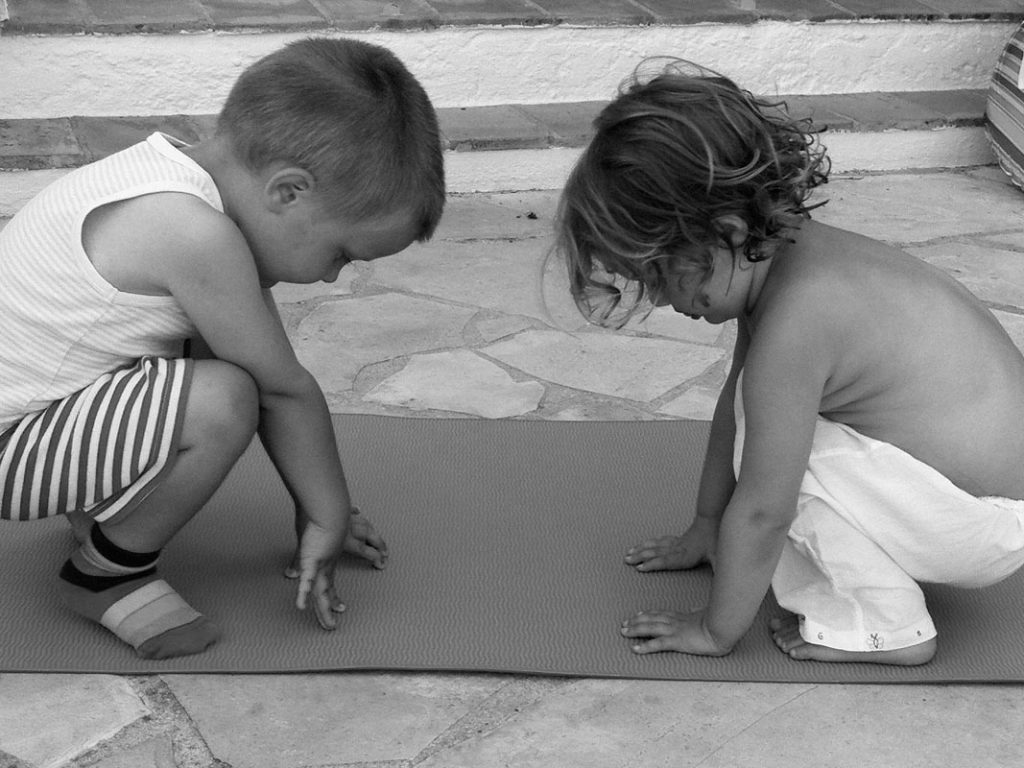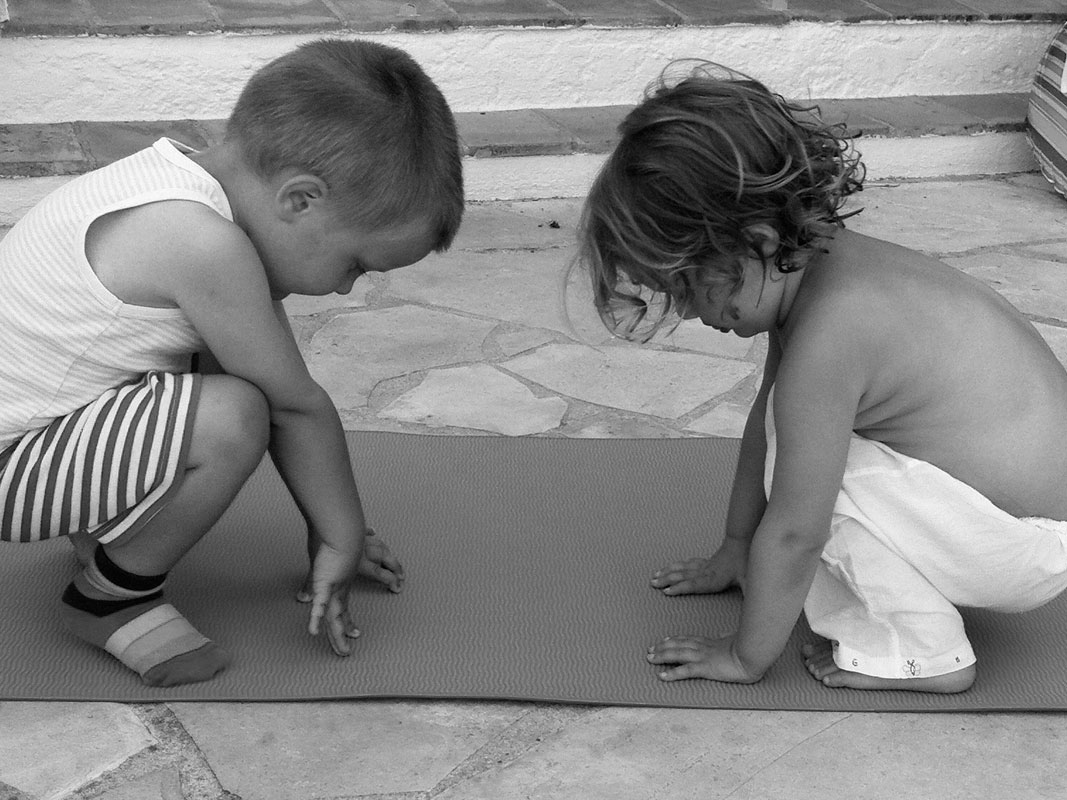How young is too young for getting some health benefits of yoga for kids?

KIDS LOVE To follow tHE PROCESS OF COPYING yoga movements
This article is by Marlynn Wei, MD, JD, Contributing Editor on Harvard Health
More than just a game: Yoga for school-age children
Yoga is becoming increasingly popular among American children. A national survey found that 3% of U.S. children (1.7 million) did yoga as of 2012 — that’s 400,000 more children than in 2007.
Yoga and mindfulness have been shown to improve both physical and mental health in school-age children (ages 6 to 12). Yoga improves balance, strength, endurance, and aerobic capacity in children. Yoga and mindfulness offer psychological benefits for children as well. A growing body of research has already shown that yoga can improve focus, memory, self-esteem, academic performance, and classroom behavior, and can even reduce anxiety and stress in children.
Emerging research studies also suggest that yoga can help children with attention deficit hyperactivity disorder (ADHD) by improving the core symptoms of ADHD, including inattentiveness, hyperactivity, and impulsivity. It can also boost school performance in children with ADHD. A growing number of schools now integrate yoga and mindfulness into physical education programs or classroom curriculums, and many yoga studios offer classes for school-age children. Yoga can be playful and interactive for parents and children at home, as well.
Jessica Mei Gershen, a certified yoga instructor who teaches yoga to children at Brooklyn Yoga Project and founder of Yoga For All Needs, recommends making yoga playful and fun for kids, whether in the classroom or at home. In her yoga classes, Gershen weaves in fun games and stories with positive themes like compassion, gratitude, and strength.
“Yoga is really effective because it’s so tangible. Learning physical postures builds confidence and strength as well as the mind-body connection,” Gershen says. She also has found that the effects of yoga go beyond physical fitness and also allow kids to build confidence and awareness beyond the classroom. “Through yoga, kids start to realize that they are strong and then are able to take that strength, confidence, acceptance, and compassion out into the world,” notes Gershen.
Simple and fun yoga exercises for kids
Here are some fun yoga exercises and games for kids. If you are a parent familiar with yoga, you can try these at home with your family.
More yoga poses for kids, as well as some other resources, can be found here.
Simple yoga breath exercise
- Take a deep breath in and hold it for a count of three.
- Breathe out forcefully, like you’re blowing out a candle.
- Repeat this for five cycles of breath.
Flying bird breath
- Stand tall, with arms at your sides and feet hip-width apart in standing Mountain Pose.
- Imagine being a beautiful, strong bird.
- Pretend to prepare to fly by inhaling and raising your arms (“wings”) until your palms touch overhead. Keep your arms straight.
- Exhale slowly as you bring your arms back down to your sides, palms facing down.
- Repeat in a steady motion with each breath: inhale as you raise your arms, and exhale as lower your arms.
- Optional: Close your eyes as you repeat the movements with breath, and imagine yourself flying in the sky like a bird.
Yoga games
Mirror, mirror. This game is a good warm-up exercise to increase focus.
- One person starts as the leader. The leader chooses a pose to do and shows it to the others.
- The other players copy the leader’s pose as if they are looking into a mirror.
- Change the leader with each round of poses, so that everyone has a turn at being the leader.
Yogi says
One person is selected as the Yogi. The other players must do the yoga poses that the Yogi tells them to do if the instruction starts with “Yogi says.” If the Yogi doesn’t use “Yogi says,” then players do not do the pose. Keep changing the person who is Yogi, so that everyone gets a turn.
Red light, green light yoga
One person is chosen as the Stoplight. He or she stands at the front of the room. The other players are the “cars,” and they start at the opposite wall. The Stoplight starts the game by calling “Green light!” The other players then use yoga poses to move forward. When the Stoplight calls “Red light!,” each player needs to be in a yoga pose and remain still. Everyone takes a turn being the Stoplight.
Meditation
Meditation can be short and simple, and does not have to involve complex yoga poses or staying still in a quiet, dark room. One parent, who is also a physician, describes playing a “meditation game” with her children before bedtime, when she turns off electronic devices and reflects on the day with her children, using questions like, “What are you grateful for today?”
Here are a few simple meditations for children, which can be done for as little as 30 seconds or for several minutes.
Mindful awareness meditation
- Find a comfortable seated position or lie down.
- Close your eyes.
- Try to listen to every single sound in the room.
Loving kindness meditation
- Find a comfortable seated position or lie down.
- Close your eyes and think about someone you love.
- Hold them tight in your heart and continue to think about that person.
Note: Pediatrician Tips is strictly a news and information website about pediatrics. It does not provide medical advice, diagnosis, or treatment. This content is not intended to be a substitute for professional medical advice, diagnosis, or treatment. Always seek the advice of your pediatrician, physician or another qualified health provider with any questions you may have regarding a medical condition for any person. Never disregard professional medical advice or delay in seeking it because of something you have read on this website. The opinions expressed in this column are not always those of Pediatrician Tips and are intended to spark discussion about issues pertaining to pediatrics and pediatricians.








